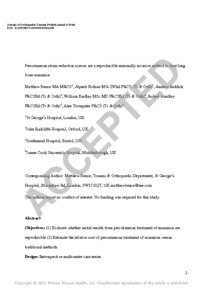Bence, M; Kothari, A; Riddick, A; Eardley, W; Handley, R; Trompeter, A
(2022)
Percutaneous strain reduction screws are a reproducible minimally invasive method to treat long bone nonunion.
J Orthop Trauma, 36 (9).
e343-e348.
ISSN 1531-2291
https://doi.org/10.1097/BOT.0000000000002368
SGUL Authors: Trompeter, Alex Joel
![[img]](https://openaccess.sgul.ac.uk/114422/1.hassmallThumbnailVersion/Percutaneous_strain_reduction_screws_are_a.36.pdf)  Preview |
|
PDF
Accepted Version
Available under License ["licenses_description_publisher" not defined].
Download (916kB)
| Preview
|
Abstract
OBJECTIVES: (1) Evaluate whether initial results from percutaneous treatment of nonunion are reproducible (2) Estimate the relative cost of percutaneous treatment of nonunion versus traditional methods. DESIGN: Retrospective multicentre case series. SETTING: Four Level 1 trauma centersPatients/Participants: 51 patients (34 men and 17 women) with a median age of 51 years (range 14 - 81) were treated for nonunion at a median of 10 months (range 4 - 212) from injury. INTERVENTION: Percutaneous strain reduction screws (PSRS). MAIN OUTCOME MEASURED: Union rates and time to union were compared for patients treated in the developing institution versus independent units as well as with previously published results. RESULTS: 45 (88%) of patients achieved union at a median time of 5.2 months (range 1.0 - 24.7) confirming the previously published results for this technique. Comparable results were seen between the developing institution and independent units. No patients experienced adverse events beyond failure to achieve union. PSRS appears to offer savings of between £3,177 ($4,416) to £11,352 ($15,780) per case compared with traditional methods of nonunion surgery. CONCLUSIONS: PSRS is a safe, efficacious treatment for long bone nonunion and may be more cost-effective than traditional non-union treatment methods. The promising initial results of this technique have now been replicated outside of the developing institution. LEVELS OF EVIDENCE: Therapeutic Level III. See Instructions for Authors for a complete description of levels of evidence.
Statistics
Item downloaded times since 16 Jun 2022.
Actions (login required)
 |
Edit Item |



